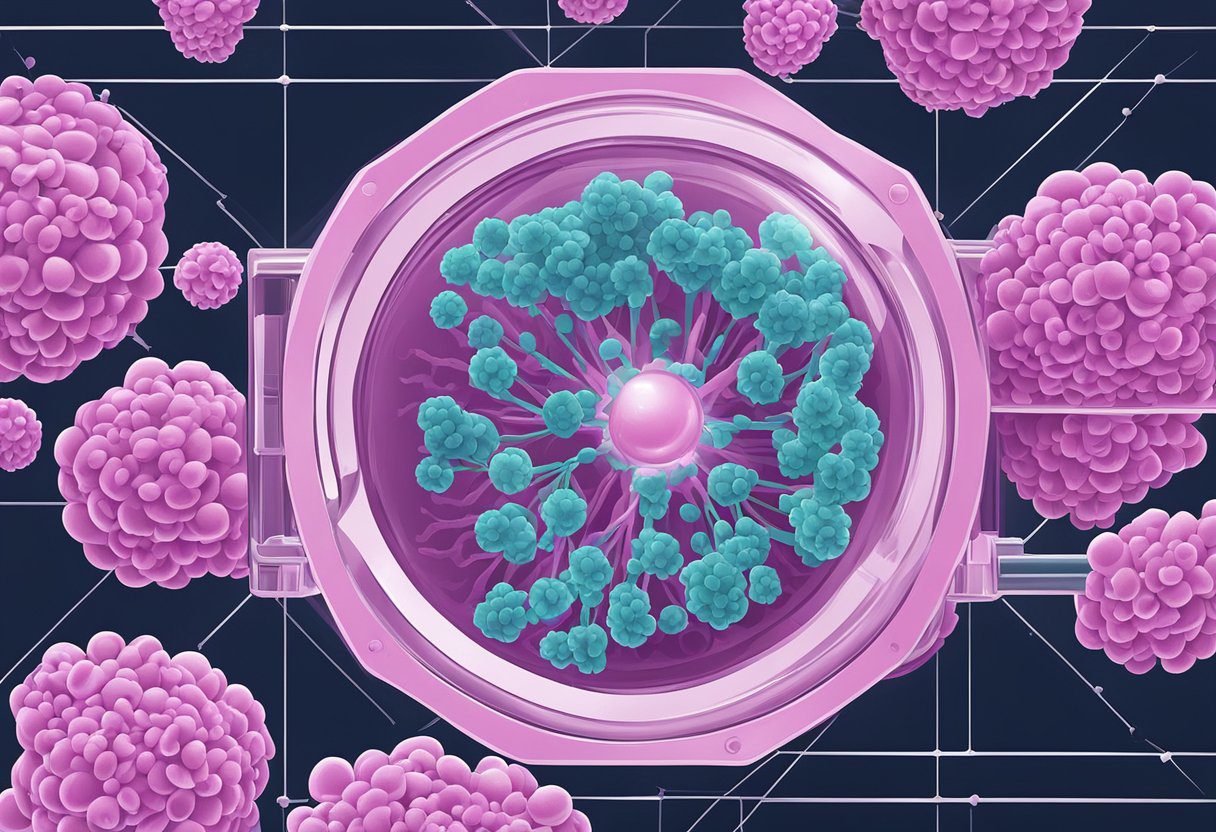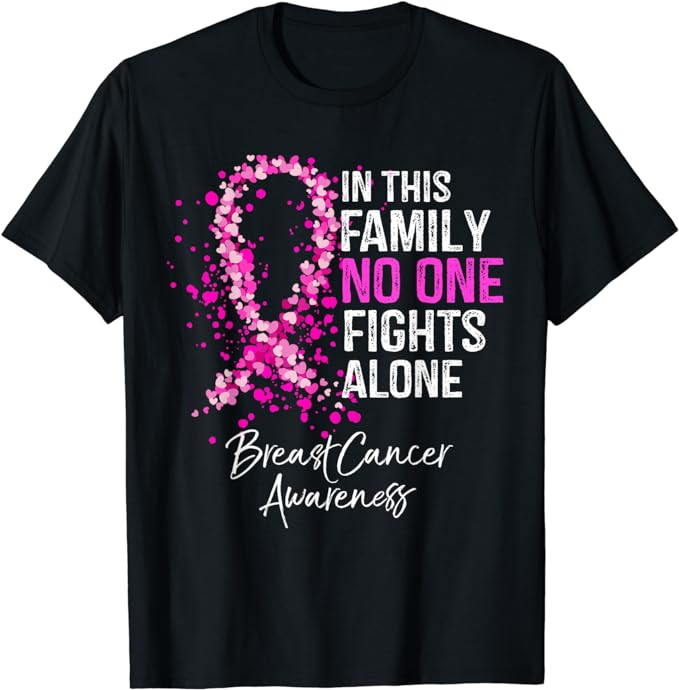Triple-negative breast cancer (TNBC) is a form of breast cancer characterized by the absence of three typically identified receptors: estrogen, progesterone, and the HER2 protein. Unlike other breast cancer subtypes, TNBC does not respond to hormonal or targeted therapies, making it more challenging to treat. The condition is more likely to affect younger women and is commonly associated with mutations in the BRCA1 gene.

TNBC can present changes in the skin, highlighting the importance of recognizing the symptoms for early detection. These changes might include alterations in texture, color, or the presence of a rash, and in some cases, nipple discharge. Due to the aggressive nature of TNBC, understanding its stages, spread, and available treatment options is crucial.
This information, along with knowledge about risk factors and epidemiology, can empower patients and healthcare providers in managing the disease.
Key Takeaways
-
- TNBC lacks three receptors, making treatment more difficult.
-
- Skin changes can indicate the presence of TNBC and warrant medical attention.
-
- Knowledge of TNBC’s nature and treatment options is essential for management.
Understanding Triple-Negative Breast Cancer

Triple-negative breast cancer (TNBC) is a challenging subtype distinguished by what it lacks compared to other forms of breast cancer. This section explores TNBC’s definition, contrasts it with other breast cancers, and explains the crucial role receptors play.
Defining TNBC
TNBC refers to breast cancer that does not express estrogen receptors, progesterone receptors, or high levels of the HER2 protein. This categorization implies that the tumor cells have tested ‘negative’ for these three receptors, which are common targets for breast cancer therapies.
TNBC vs. Other Breast Cancers
Compared to hormone-receptor-positive types of breast cancer, which depend on estrogen or progesterone to grow, TNBC behaves differently. It lacks the presence of these hormones as well as excess HER2 protein, which means standard treatments like hormone therapy and drugs that target HER2 are ineffective against TNBC.
The Significance of Receptors
In breast cancer, receptors play a crucial role in the growth and spread of cancer cells. The absence of estrogen and progesterone receptors and HER2 protein in TNBC makes it more difficult to treat, as these are integral targets for many treatments. This highlights the need for more research and innovative treatments for TNBC.
Symptoms and Detection

Recognizing the signs of Triple Negative Breast Cancer (TNBC) and employing methods for its detection are critical for timely diagnosis and treatment. Awareness of specific symptoms and the appropriate diagnostic tests can significantly influence outcomes.
Common Symptoms of TNBC
TNBC can present a variety of symptoms that warrant attention. A new lump or mass in the breast, often detected through self-examination, is one of the most common indicators. Patients may also experience breast pain or swelling in parts of or the entire breast.
Breast Changes and Physical Signs
Physical changes in the breast are key indicators of TNBC. These include texture changes resembling an orange peel, known as peau d’orange, and skin redness. The breast may show dimpling, and there could be nipple retraction where the nipple turns inward. Nipple discharge that is unusual in color or consistency should also be examined promptly.
Diagnostic Imaging and Tests
For detection, mammograms and ultrasound are primary imaging tests used to identify abnormalities in breast tissue. A physical examination by a healthcare professional can further assess any suspicious changes. If initial screenings suggest TNBC, more detailed imaging or a biopsy may be recommended to confirm the diagnosis.
Stages and Spread of TNBC

Triple-Negative Breast Cancer (TNBC) progression and treatment outcomes are significantly influenced by both its stage at diagnosis and the extent of its spread. Precise staging helps guide clinical decisions, impacting prognosis.
Staging of Breast Cancer
Staging of breast cancer is crucial for determining the extent of the cancer and the most appropriate treatment plan. The TNBC staging system is based on the size of the tumor and whether cancer has spread to the lymph nodes or other parts of the body:
-
- Stage 1: This early stage indicates a small tumor (up to 2 centimeters) that has not spread to lymph nodes.
-
- Stage 2: This stage might involve a larger tumor (2 to 5 centimeters) or cancer that has spread to a few nearby lymph nodes.
-
- Stage 3: Cancer is locally advanced, may be larger than 5 centimeters, and may have spread extensively to lymph nodes but not to distant sites.
-
- Stage 4: Indicates that cancer has metastasized to distant parts of the body such as the liver, lungs, bone, or brain.
Metastasis and Secondary Cancers
When TNBC spreads beyond the breast and nearby lymph nodes, it is considered to be metastatic, presenting as secondary cancers in other parts of the body:
-
- Lymph Nodes: Swollen lymph nodes can be a sign that TNBC has begun to spread.
-
- Bone: If cancer cells reach the bone, they can cause lesions and bone pain.
-
- Liver: The liver might be affected, leading to symptoms like jaundice or abdominal pain.
-
- Brain: Brain involvement can cause neurological symptoms, depending on the location and size of the metastasis.
-
- Lungs: The presence of cancer in the lungs often leads to breathing difficulties or a persistent cough.
Risk Factors and Epidemiology

Triple-Negative Breast Cancer (TNBC) is a type of breast cancer defined by the absence of estrogen and progesterone hormone receptors and the HER2 protein. It is relevant to investigate epidemiological trends and identify risk factors that may predispose an individual to TNBC.
Identifying Risk Factors for TNBC
Studies suggest that various risk factors contribute to the likelihood of developing TNBC. Individuals with a BRCA1 mutation exhibit a higher predisposition to this subtype of breast cancer. Additionally, emerging research indicates that lifestyle factors such as obesity and reproductive history may also influence risk levels. Notably, premenopausal women seem more susceptible to TNBC, and race plays a critical role, with African American women showing higher incidence rates compared to other racial groups.
Age and Demographics Related to TNBC
Age is a significant factor in the epidemiology of TNBC. This type of breast cancer is more commonly diagnosed in women under the age of 40, compared to hormone receptor-positive types of breast cancer. Demographics also impact prevalence; for instance, Hispanic women have a lower incidence of TNBC than non-Hispanic women.
Treatment Options and Management

In managing Triple-Negative Breast Cancer (TNBC), treatment options are aimed at both controlling the disease and alleviating symptoms. Surgical interventions, chemotherapy, and radiotherapy constitute the mainstay treatments, while emerging therapies and clinical trials offer hope for future advancements.
Surgical Interventions
Surgery is a critical step in the treatment of TNBC. Options include a mastectomy, where the entire breast is removed, or breast-conserving surgery such as a lumpectomy, where only the tumor and a small margin of surrounding tissue are excised. The choice of surgery depends on the tumor size, location, and patient’s preference, taken after thorough discussion with their healthcare provider. Surgical removal of the tumor aims to achieve clear margins, which is crucial for reducing the recurrence rate. Post-surgery, a biopsy of the removed tissue can give valuable information about the cancer stage and guide further treatment.
Chemotherapy and Radiotherapy
Chemotherapy for TNBC involves using chemotherapy drugs that target and kill rapidly dividing cancer cells.
Neoadjuvant chemotherapy is administered before surgery to shrink the tumor, which may allow for less extensive surgery and can provide information about the tumor’s response to treatment. After surgery, adjuvant chemotherapy may be given to eliminate any lingering cancer cells, aiming to decrease recurrence and improve survival rates.
Radiotherapy is often recommended following lumpectomy to eliminate residual cancer cells and reduce the recurrence rate. The potential side effects of chemotherapy and radiation, such as fatigue and pain, should be discussed with patients to manage expectations and improve outcomes.
Emerging Therapies and Clinical Trials
Ongoing clinical trials are revolutionizing the treatment of triple-negative breast cancer. These trials explore emerging therapies and their effectiveness in treating TNBC.
Immunotherapy is one such emerging therapy that harnesses the body’s immune system to fight cancer. It has shown promising results, particularly when combined with chemotherapy.
Newer treatment options like PARP inhibitors, antibody-drug conjugates, and platinum chemotherapy are also being evaluated for their effectiveness in TNBC. Targeted therapies focus on specific characteristics of cancer cells, offering a more personalized treatment approach.
Clinical trials also give insight into novel treatments and are essential for enhancing the TNBC survival rate. They may provide access to cutting-edge treatments not yet widely available, so patients should consider participating in a clinical trial in consultation with their healthcare providers.
Prognosis and Outcomes

The prognosis of Triple-Negative Breast Cancer (TNBC) varies, with survival rates and recurrence being key factors affecting patient outcomes. Interventions often include a combination of medications and support mechanisms to manage this less common form of breast cancer.
Survival Statistics and Recurrence
Triple-Negative Breast Cancer is known for its aggressive nature and higher chances of recurrence compared to other types of breast cancer. The five-year survival rate for TNBC is approximately 77%, contrasting with a 91% survival rate for all breast cancers combined.
Recurrence of TNBC is more common, usually within the first 3-5 years post-treatment.
-
- Five-year survival rate: 77%
-
- General breast cancer survival rate: 91%
-
- Recurrence: Most likely within 3-5 years after treatment
Although the outlook can be challenging, early and aggressive treatment can improve these statistics significantly. Some studies mention that over 80% of early-stage TNBC patients may experience prolonged survival post-treatment. For more detailed statistics and context, please refer to the findings in the characteristics and prognosis of TNBC patients study.
Quality of Life and Support
The quality of life for TNBC patients can be significantly impacted by the disease and its treatment. These patients may experience a range of physical and emotional challenges that necessitate ongoing support.
Support groups and counseling services are essential components of comprehensive care, offering emotional and social assistance.
-
- Support systems include:
-
- Support groups
-
- Counseling services
-
- Support systems include:
TNBC treatment may involve medications that are less commonly used in other forms of breast cancer. This is because TNBC lacks hormone receptor expression, necessitating a tailored approach to therapy.
Access to robust support networks and the availability of specialized medications play a critical role in managing the disease and enhancing patient well-being. For insights into symptom management and treatment options, further information is available through Cleveland Clinic’s overview of TNBC.
Prevention and Early Detection

Early detection and prevention of Triple Negative Breast Cancer (TNBC) are crucial in improving prognosis and treatment outcomes. Key strategies include recognizing risk factors and ensuring consistent screenings for early signs of cancer development.
Lifestyle Factors and Preventive Measures
Lifestyle modifications can play a role in reducing the risk of developing TNBC.
These include maintaining a healthy weight, participating in regular physical activity, and minimizing alcohol consumption.
Diet also has an impact; a balanced diet rich in fruits, vegetables, and whole grains is recommended.
Environmental exposures, such as prolonged and unprotected sun exposure, should be minimized as it can increase the risk for other types of skin cancer which could spread to other areas including breast tissue.
Importance of Regular Screening
Regular screening is vital for the early diagnosis of TNBC, as this form of breast cancer can be aggressive and may spread quickly.
Clinical breast exams and mammograms are considered critical tools.
Women are advised to discuss their screening schedule with their healthcare provider. This is especially important if they have a family history of breast cancer, as they may need to be screened more frequently or start screening at an earlier age.
For those diagnosed with TNBC, determining the cancer stage is essential to decide the appropriate treatment plan.
Early stages can often be managed more effectively than later stages where the cancer has spread. It is important for women to be informed about changes in their breasts and to seek medical advice if they detect any abnormalities to allow for timely breast cancer diagnosis.
Patient Resources and Support

Patients with triple negative breast cancer (TNBC) may encounter challenges finding targeted treatments due to fewer treatment options. However, access to accurate information and support networks can play a pivotal role in their treatment journey and potentially improve survival rates.
Access to Information
Patients require dependable resources to understand their condition and the treatments available.
Clinical trials offer hope for new treatments and can be a crucial option for those seeking alternatives to standard therapies.
For comprehensive information on treatment, the Patient Resource offers insights into evolving therapies for TNBC.
Support Groups and Community
Support groups provide a platform for sharing experiences and emotional support, which is invaluable for patients and their families.
The Triple Negative Breast Cancer Foundation connects individuals with a community that understands the unique challenges of living with metastatic TNBC.
Regular involvement in support groups can offer comfort and guidance, helping patients navigate through the complexities of the disease.
Advancements in TNBC Research

Recent innovations in Triple Negative Breast Cancer (TNBC) research have unveiled promising developments. These include new approaches in clinical trials and targeted therapy, aimed at addressing the aggressive nature of TNBC which typically lacks hormone receptors and HER2 expression.
Clinical Trials and New Treatments
Clinical trials have become a cornerstone for advancing TNBC treatment.
One notable approach is the exploration of antibody-drug conjugates (ADCs), which deliver cytotoxic agents directly to cancer cells while sparing healthy tissue.
For instance, newly advanced ADCs show potential in improving outcomes for TNBC patients.
Additionally, PARP inhibitors have emerged from clinical trials as an effective option for patients with BRCA mutations. They help to repair DNA damage in cancer cells and cause their death.
Breakthroughs in Targeted Therapy
Targeted therapies are steering TNBC treatment towards more personalized and precise interventions.
Unlike hormone therapy, which is ineffective in TNBC due to the absence of hormone receptors, researchers are focusing on identifying molecular targets unique to TNBC cells.
This has led to the design of therapies that disrupt specific cellular processes involved in TNBC progression.
Advancements in genomic techniques and molecular subtyping have played a pivotal role in developing these novel targeted treatments, providing a beacon of hope for improving TNBC patient outcomes.
Frequently Asked Questions

Triple-negative breast cancer (TNBC) can affect the skin, leading to specific symptoms and requiring distinct treatments. This section addresses critical queries about skin metastasis, symptoms on the skin, treatment modalities, initial signs, recent treatment advancements, and contributing factors of TNBC.
What are the symptoms of skin metastasis in triple-negative breast cancer?
Symptoms of skin metastasis in TNBC may include new lumps in the skin, changes to skin texture, inflammatory skin changes, and the presence of ulcerative growths.
It is essential to monitor for any new or unusual skin changes and consult with a healthcare provider for appropriate evaluation.
How does triple-negative breast cancer present on the skin?
TNBC may present on the skin as rapidly growing nodules or as an inflammatory process that resembles a skin infection.
Occasionally, the skin may appear dimpled, similar to the surface of an orange, known as peau d’orange.
What are common treatments for triple-negative breast cancer?
Common treatments for TNBC often involve a combination of surgery, chemotherapy, and radiation therapy.
Since TNBC cells lack certain receptors, targeted therapies are not typically an option, but chemotherapy can be effective.
What are the initial signs of triple-negative breast cancer?
The initial signs of TNBC can include a palpable mass in the breast, changes in breast size or shape, skin dimpling, and nipple retraction.
It’s crucial for individuals to participate in regular screening and to report any new breast changes to a healthcare provider promptly.
What are recent advancements in the treatment of triple-negative breast cancer?
Recent advancements include the development of new drugs like PARP inhibitors and immunotherapies, which have shown promise in treating certain subsets of TNBC.
Clinical trials are ongoing to discover more effective treatment options for TNBC patients.
What underlying factors contribute to the development of triple-negative breast cancer?
Risk factors for developing TNBC include genetic predispositions, such as mutations in the BRCA1 gene. Other risk factors are younger age, African ancestry, and having previously untreated breast cancer.
TNBC is a complex disease. Research is ongoing to understand the full range of contributing factors.
